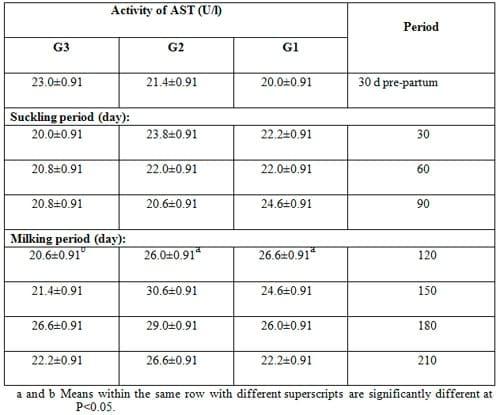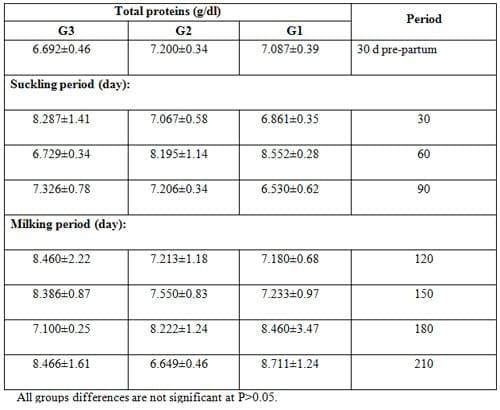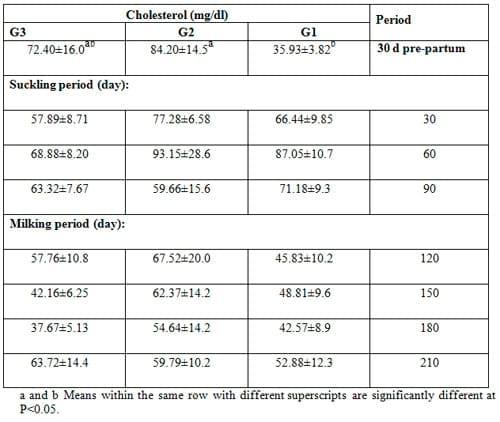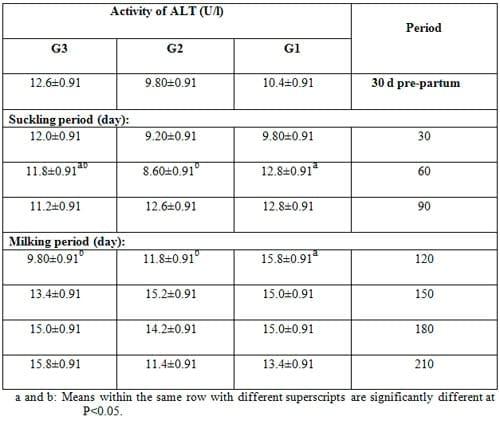INTRODUCTION
Ruminants have unique ability to utilize the fibrous material through anaerobic fermentation (Kibria et al., 1991), therefore, sunflower seed meal (SFM) can be efficiently used as a sole source of supplemental protein for ruminants (Lardy and Anderson, 2002). Cottonseed cakes (CSC) are being traditionally used as a feed for dairy animals. However, limited supply and seasonal availability of CSC result in high price. On the other hand, SFM is cheaper protein source and can be used as ruminants feed supplement (Yunus et al., 2004). Protein is the most expensive feed ingredient in animal ration and there was always shortage in its supply particularly in developing countries. This shortage is very critical in both human and animal nutrition (Yagoub and Talha, 2009). Traditionally, the farmers have been using cottonseed cakes for feeding their livestock as a source of vegetable protein and its prolonged use can affect the fertility of these animals (Zahid et al., 2003). Earlier investigations (Garcia et al., 2004) indicated that sunflower meal was equally good in performance, yet the cost of sunflower meal based rations was the lowest. In previous study, El-Sanafawy (2008) obtained beneficial effects, i.e. economic value of ration containing 5 or 10% sunflower as seed on growth performance and feed utilization of Zaraibi does. Therefore, the present study was conducted to evaluate the effect of replacing concentrate feed mixture containing cotton seed cake by 15 or 20% of whole sunflower seeds on blood profile of does.
MATERIALS AND METHODS
This research is the third part of a serial number of studies on Zaraibi goats (an Egyptian breed) fed a basal ration consisting of 25% concentrate feed mixture (CFM) beside 75% fresh berseem (clover, Trifolium alexandrinum) during winter feeding or 50% CFM and 50% berseem hay (BH) during summer feeding. The CFM consisted of cotton seed cake, linseed cake, yellow corn, wheat bran, molasses, calcium chloride and common salt. Goats of all groups were given the NRC feeding requirements (NRC, 2001) for production of 1-2 kg milk/head/day. The daily feed intake per doe composed of 1.250 kg CFM at 8.00 a.m. + 4 kg green berseem or 1.3 kg berseem hay twice daily (11 a.m. and 3 p.m.). At the late stage of pregnancy (last month of pregnancy, all experimental does (n=30) were divided into three experimental groups according to their age, weight and milk production. Goats in the 1st group (G1) served as a control group and were fed the basal ration (control). However, does in the 2nd (G2) and 3rd (G3) groups were fed the control ration, but 15 and 20% of CFM was replaced by whole sunflower seeds, respectively.
The blood samples were monthly taken from the last month of pregnancy stage up to the end of the experimental period. Blood samples were taken from the jugular vein of all animals in each group before morning feeding in vacotainer tubes. After clotting, blood samples were centrifuged at 3000 rpm/min for 15 min, and then blood serum was separated and stored at -20 °C until analysis. In blood serum, concentrations of total proteins (Henry, 1964), triglycerides (Scheletter and Nussel, 1975) and total cholesterol (Rolschlau, 1974) were determined. Also, activity of asprtate aminotransferase (AST) and alanine aminotransferase (ALT) was determined in blood serum (Harold, 1975). All analyses were conducted using spectrophotometer and commercial kits.
Data obtained in this study were subjected to statistical analysis using General Linear Models Procedures (GLMP) adapted by SPSS for windows (2004) for user’s guide. Duncan test of SPSS programme was done to determine the degree of significance between the means at P<0.05.
RESULTS AND DISCUSSION
Blood biochemicals:
Concentration of total protein (g/dl):
Averages concentration of total proteins (g/dl) in blood serum of goat does in different experimental groups pre-partum, during suckling and milking periods are presented in Table 1. Results show that total proteins concentrations pre-partum and at different times of suckling and milking periods were not affected significantly by dietary treatment, ranging between 6.530 and 8.711 g/dl. The concentration of biochemical indicators exclusively in healthy goats and did not observe any aberrations from the physiological values (Nazifi et al., 1999). Feeding supplemental fat has given variable results when used to improve productivity in domestic ruminant management (Funston, 2004).
Table 1: Effect of feeding experimental diets on total proteins concentration (g/dl, mean ± SE) in blood serum of does pre- partum and during suckling and milking periods.
In disagreement with the results of goats in this study, Baragnit et al. (2003) found that total proteins concentration was higher in serum of buffaloes fed supplemental oil than those fed control ration. Also, in dairy cows fed supplemental fats (Bruckmaier et al., 1998) and calves fed protected fat rations (Abou El-Hamed, 2003), blood concentration of total proteins was higher than those in the controls. Generally, total proteins concentrations for all experimental groups are within the normal values of Zaraibi goats as reported by El-Sanafawy (2008), which may indicate that feeding rations containing 15 or 20% SFS did not affect protein metabolism in goats.
Concentration of triglycerides (mg/dl):
Averages concentration of triglycerides (mg/dl) in blood serum of goat does in different experimental groups pre-partum and during suckling and milking periods are presented in Table 2. Results show that triglycerides concentration pre-partum and at different times of suckling and milking periods were not affected significantly by dietary treatment. The lack of significant variation of serum triglycerides is in accordance with the opinion indicated that lactating goats were not influenced by diets differing in type and level of fat (Bernard et al., 2005).
Table 2: Effect of feeding experimental diets on triglycerides concentration (mg/dl, mean ± SE) in blood serum of does pre- partum, and during suckling and milking periods.

The values of serum triglycerides are usually considered as indicators of good nutrition (Bertoni, 1989). Triglycerides increase in the presence of an altered regulatory mechanism of the lipid metabolism or due to degenerated hepatic function. It is of interest to note that serum triglycerides concentration showed a correlation with milk fat levels (Zicarelli, 1988). It is well known, in fact, that the NEFA which are released at early lactation following intense fat mobilization, are used by the liver for the synthesis of the triglycerides only if the balance between energy absorbed from the diet and that emitted due to production is not especially deficit (Bertoni et al., 1997). The results of this study and the previous studies about the nutrition- related changes on the blood triglycerides concentration of goats show that these parameters may either decrease or increase as a consequence of nutritional constraints, thus confounding their interpretation as nutritional biomarkers (Soveri et al., 1992). Other blood constituents related to lipid metabolism and energy balance, such as free fatty acids and glycerol (Larsen and Blix, 1985), polyunsaturated fatty acids (Soppela et al., 2000) or β-hydroxybutyric acid (Milner et al., 2003) may be useful as additional or alternative indicators of lipolysis during nutritional constraints in goats.
Concentration of cholesterol (mg/dl):
Data of Table 3 illustrate the effect of high-fat diets on goats. The mean serum cholesterol concentrations were 35.93, 84.20 and 77.40 mg/dl for G1, G2 and G3, respectively at -30 days of kidding. The corresponding values at 90 days were 71.18, 59.66 and 63.32 mg/dl. The values of serum cholesterol are usually considered as an indicator of good hepatic lipoproteins production used as carriers of triglycerides, synthesized from NEFA. Total cholesterol and HDL-fractions indirectly reflect the degree of exogenous energy availability and the hepatic functionality: its levels rise owing to a moderate negative energetic balance: lactation, low temperatures and high thermal ranges (Campanile et al., 1994). The results of this study and the previous studies about the nutrition- related changes in the blood cholesterol concentration of ruminants show that these parameters may either decrease or increase as a consequence of nutritional constraints, thus confounding their interpretation as nutritional biomarkers (Soveri et al., 1992). Other blood constituents related to lipid metabolism and energy balance, such as free fatty acids and glycerol (Larsen and Blix, 1985), polyunsaturated fatty acids (Soppela et al.,2000) or β-hydroxybutyric acid (Milner et al., 2003) may be useful as additional or alternative indicators of lipolysis during nutritional constraints in goats.
Table 3: Effect of feeding experimental diets on cholesterol concentration (mg/dl, mean ± SE) in serum of does during pre-kidding, suckling and milking periods.
The postpartum increase in the levels of cholesterol in the peripheral blood of cows to day 56 of the observed period was reported by Bekeová et al. (1987). A decrease in the concentration of cholesterol brings a decrease in the low-dense lipo-proteins, whose metabolism is closely connected with the effect of estrogens (Brown et al., 1981). Krokavec et al. (1992) reported that the metabolic profile parameters in goats during the whole year. Dependence of some biochemical parameters in the blood serum of goats on the phase of reproduction cycle was reported by Aldasy et al. (1981) and on supplementary protein diet in Angora goats by Gregoire et al. (1996).
Enzymatic activity:
Activity of aspartate aminotransferase (AST, U/l):
Activity of AST in blood serum of goats as affected by the experimental rations pre-partum, and during suckling and milking periods is presented in Table 4. Results show that activity of AST was not affected significantly by dietary treatment at all sampling times, except during the 1st month of the milking period (120 days post-partum), where activity of AST was significantly (P<0.05) decreased in does fed 20% SFS ration compared with 15% SFS and control rations.
Table 4: Effect of feeding experimental diets on activity of AST (U/l, mean±SE) in blood serum of does pre-partum and during suckling and milking periods.

In accordance with the present results, Abo-Donia (2003) found slight increase in AST activity from 26.63 to 26.93 U/l in ewes fed diets treated with fish oil, but their values were within the normal range. However, Moallem et al. (1997) found that the activity AST was higher in cows fed fat as compared to cows fed ration without any additives. It is known that AST transfers the amino group from aspartate to ketoglutaric acid, forming glutamate and oxaloacetate. In ruminants, AST is present with higher activity in the muscles and heart as opposed to the liver, and increases in serious cases of prolonged fasting and infectious, and nutritional liver disease. It increases only in the case of extensive hepatic necrosis. It can be referred to muscular cells damage and tissue changes related to the neonatal phase in buffalo calves (Campanile et al., 1997). The pathological changes in the liver elevate the activity of AST in the blood (Kaneko, 1989) and level of AST in conjunction with other enzymes may be used as a useful indicator for hepatic or muscular damage.
Alanine aminotransferase (ALT, U/l):
Activity of ALT in blood serum of goats as affected by the experimental rations pre-partum, and during suckling and milking periods is presented in Table 5. Results show that activity of ALT was not affected significantly by dietary treatment at all sampling times, except at 60 days of the suckling period and 120 days of the milking period, where activity of ALT was significantly (P<0.05) decreased in does fed 15 or 20% SFS rations. This enzyme transfers amino group from alanine to ketoglutaric acid, forming glutamate and piruvate. In ruminants, ALT is present with lower activity in the liver (Borghese, 1994). Decreasing metabolism is linked to lower ALT hematic concentrations, while thyroid hormones, particularly T4, induce a greater emission of the enzyme, throughout increasing mitochondria membrane permeability (Campanile et al., 1997). In accordance with the present results, Abo-Donia (2003) found slight increase in ALT activity from 17.36 to 17.97 U/l in ewes fed diets treated with fish oil, but their values were within the normal range. The observed insignificant differences in activity of AST and ALT at most sampling times between treatment groups and the control one, and even the reduction in these activities in treatment groups at some sampling times may indicate normal liver function of does fed 15 or 20% SFS rations. Beside the normal ranges of AST and ALT activities and of total protein concentration in blood serum of does indicated a good nutritional status and their livers function was in a normal pathological condition as reported by El-Sayed (1991).
Table 5: Effect of feeding experimental diets on ALT activity (U/l, mean ± SE) in blood serum of does pre-partum and during suckling and milking periods.
REFERENCES
Abo-Donia, F. M. A. (2003). Using different sources of soap-stock as non-conventional source of energy in sheep rations. Egypt.J. of Nutr. and Feeds 6 (Special Issue): 1381.
Abou El-Hamed, M. A. M. (2003). Ruminal development in suckling calves fed protected fat and protected protein. Ph. D. Thesis, Fac. Agric.,Mansoura Univ.Egypt.
Aldasy P. ; P. Bajáky and T. Eerrus (1981). Vér alapertek tejhasznu kecske lomanyban. Magy. Állatorv. Lap., 36, 536 –538.
Baraghit, G. A.; N. M. El-Kholy ; S.S. Omar ; B.M. Ahmed and K.I. Zedan (2003). Effect of dietary fat sources of digestibility, rumen fermentation and blood parameter of buffalo calves.EgyptJ. Nutr. Feeds, 6: 663–74.
Bekeová E. ; J. Elecko; V. Hendrichovský ; J. Choma and; M. Krajnicakova (1987). The effect of beta-carotene on the changes in T4 and cholesterol concentrations in calving heifers before and after parturition. Vet. Med. (Praha), 32: 459 – 468.
Bernard, L. ; J. Rouel ; C. Leroux ; A. Ferlay ; Y. Faulconnier ; P. Legrand and Y. Chilliard (2005). Mammary lipid metabolism and milk fatty acid secretion in alpine goats fed vegetable lipids. J. Dairy Sci., 88:1478–1489.
Bertoni, G. (1989). Effetti e livello ematico e produttivo della
somministrazione di grasso animale a bovine da latte ante e post partum. Zoot. Nutr. Anim., 15 (4): 341-354.
Bertoni, G. ; S. Bartocci ; C. Piccioli and A. Amici (1997). Blood metabolites and hormone changes in lactating buffaloes fed diets different for energy content and protein degradability. Proc. Fifth WorldBuffaloCongress.Caserta, Italia: pp. 961-965.
Borghese, A. (1994). Studio dei profili ematici come indicatori dello stato fisiopatologico degli animali in produzione zootecnica. Biologia Oggi., VIII (1-2): 91-112.
Brown M. S. ; P. T. Kovanen and J. L. Goldstein (1981). Regulation of plasma cholesterol by lipoprotein receptors. Science, 212: 628 – 635.
Bruckmaier, R. M. ; L. Gregoretti ; F. Jans ; D. Fissler and J. W. Blum (1998). Longissimus dorsi muscle diameter, back fat thickness, body condition scores and skin fold values related to metabolic and endocrine traits lactating dairy cows fed crystalline fat or free fatty acids. J. Vet. Med. 45: 261-270.
Campanile G. ; L. Avallone ; A. d’Angelo ; R. Di Palo and C. Di Meo (1994). Influence of season and of the number of days after calving on the pattern of thyroid hormones in buffalo cows. Proc. IV WorldBuffaloCongress,Sao Paulo, Brasil, 27–30 June, 3: 564–567.
Campanile, G, ; R. Di Palo ; R. D’Angelo and A. Haemato (1997). Logical profile in buffalo. Bubalus bubalis Suppl.,4:236–249.
El-Sanafawy, H. A. (2008). Performance of goats fed on rations containing whole sunflower seeds. M. Sc. Thesis, Fac. Agric., Kafer El-Sheikh Univ.
El-Sayed, H. M. (1991). Performance of growing ruminants on high energy density diets. Ph. D. Thesis, Fac. of Agric.,Ain-Shams Univ.,Egypt.
Funston, R. N. (2004) Fat supplementation and reproduction in beef females. J. Anim. Sci., 82: 154-161.
Garcia, J.A.; S. P. de F. Vieira; P. R. Cecon; G. M. P. de Melo; A. de S. Martins and M. C. Stti (2004). Apparent digestibility of sunflower meal in growing dairy cattle feeding. Ciencia Anim. Brasileira, 5 (3): 123-129.
Gregoire, R. J. ; M. F. Fahmy ; J. M. Boucher ; A. Tremblay and J. Mercier (1996). Effect of four protein supplements on growth feed conversion, mohair production, fibre characteristics and blood parameters ofAngoragoats. Small Ruminant Res., 19: 121 –130.
Harold, P. C. (1975). Determination method of GOT and GPT. Laboratory Anim. Sci., 43(3): 244-246.
Henry, E. J. (1964). Calorimetric determination of total protein. Clin. Chem. Principles and Technics. HarperRowNY, pp. 181.
Kaneko, J. J. (1989). Clinical Biochemistry of Domestic Animals, 4th Edition. Academic Press,New York.
Kibria, S. S.; M. R. Islam and C. K. Shah (1991). Development of straw based ration for feeding ruminants. Asian-Aust. J. Anim. Sci., 4: 235-240.
Krokavec M. ; K. Simo ; A. Martinko and M. Krokavcová (1992). A study of the values of metabolic profile parameters in the large- scale breeding of goats throughout the seasons of the year. Vet. Med. (Praha), 37: 113 –118.
Lardy, G. P. and V. Anderson (2002). Canola and sunflower meal in beef cattle diets. Vet. Clinics of North America: Food Animal Practice, 18: 327-338.
Larsen, T. S. and A. S. Blix (1985) Seasonal changes in total body water, body composition and water turnover in reindeer. Rangifer, 5(1): 2-9.
Milner, J. M. ; A. Stien ; R. J. Irvine ; S. D. Albon ; R. Langvatn and E. Ropstad, (2003) Body condition in Svalbard reindeer and the use of blood parameters as indicators of condition and fitness.Can.J. Zool., 81: 1566-1578.
Moallem, U. ; M. Kaim ; Y. Folman and D. Sklan (1997). Effect of calcium soap of fatty acids and administration of somatotropin in early lactation on productive and reproductive performance of high producing dairy cows. J. Dairy Sci., 80: 2127.
Nazifi, S. ; S. Dehghani and H. R. Gheisari (1999). Biochemical and cytologic properties of blood and peritoneal fluid in clinically normal adult goats. Vet. Arhiv., 69: 221-227.
NRC (2001). Nutrient Requirements of Dairy Goats. 7th Rev. ed. National Academy Press,Washington,DC.
Rolschlau, P. (1974). Klin. Biochem. 12: 226.
Scheletter, G. and E. Nussel (1975). Arbeitsned Sozialnd Pracentined 10: 25.
Soppela P. ; U. Heiskari; M. Nieminen;I.Salminen; S. Sankari and H. Kindahl (2000). The effects of a prolonged undernutrition on serum lipids and fatty acid composition of reindeer calves during winter and spring. Acta Physiol. Scand., 168: 337-350.
Soveri, T. ; S. Sankari and M. Nieminen (1992) Blood chemistry of reindeer calves (Rangifer tarandus) during the winter season. Comp. Biochem. Physiol., 102A:191-196.
SPSS for windows (2004). Statistical Package for Social Science (SPSS). Release 13.0. The Apasche software foundation for windows.
Yagoub, M. Y. and S. A. Talha (2009). Effect of compensatory growth on performance of Sudanese female goats.PakistanJournal of Nutrition, 8 (11): 1802-1805.
Yunus, A. W. ; A. G. Khan; Z. Alam; J. I. Sultan and M. Riaz (2004). Effect of substituting cottonseed meal with sunflower meal in rations for growing buffalo calves. Asian- Aust. J. Anim. Sci., 17: 659-662.
Zahid,I.A. ; L. A. Lohdi; N. Ahmed; N. U. Rehman and M. S. Akhtar (2003). Effects of cotton seed cake (gossypol) on live weight of teddy male goats.PakistanVet. J., 23: 27-30.
Zicarelli, L. (1988). Variazioni stagionali ed aziendali del profilo metabolico nei bufali. Zoot. Nutr. Anim., 8: 321-356.











.jpg&w=3840&q=75)